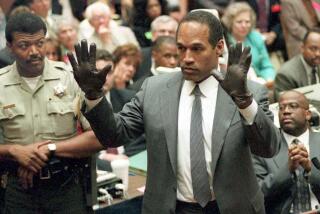Media’s Role in Drama Debated
- Share via
WASHINGTON -- The pattern is chilling, as if the sniper is watching experts on television predict his next move -- and then acting on it.
Robert Ressler, a former FBI profiler, suggests on CNN’s “Larry King Live” that the sniper might travel as far south as Richmond, Va., perhaps “down to Ashland.” The next day, a 37-year-old man is shot in the stomach leaving the Ponderosa steakhouse in Ashland, Va.
Gregg McCrary, a former FBI psychological profiler, tells CBS News on a Friday that the sniper has “a God complex, killing these people at random and from a long distance.”
The next Monday, a 13-year-old boy is shot after being dropped off at school. The sniper reportedly leaves behind a tarot card, the death card, inscribed with the message: “Dear Mr. Policeman, I am God.”
And Bo Dietl, a former New York detective who served as the model for the lead character in the film “One Tough Cop,” tells CNN audiences the sniper is “a coward.” More shootings follow.
“We’re egging him on,” said Dorothy Otnow Lewis, a clinical professor at Yale University and author of “Guilty by Reason of Insanity: A Psychiatrist Explores the Minds of Killers.”
Fuming at the guests who appeared before her Friday on Larry King’s show, she admonished them not to challenge the sniper. “You don’t challenge,” she told the panelists. “You don’t say, ‘You’re a coward,’ you don’t say, ‘You’re not a good sniper,’ because that’s an invitation to go out and prove that he’s really the world’s best sniper.”
As the carnage has mounted, media coverage of the sniper attacks that are terrorizing the Washington area has come under the usual criticisms.
Some argue that the media are only fueling public fear. Others, particularly in law enforcement, are furious at media disclosures of information such as the location of roadblocks. There are even complaints about the logos networks are using. CNN’s “Sniper on the Loose” is a frequently cited example.
But what distinguishes the sniper case from earlier serial murders where the killer appeared to be following coverage of his spree is that the coverage is now continuous. With police reluctant to give out too much information, producers are filling the airwaves with chatter from a variety of talking heads.
“It’s agonizing,” said Frank Sesno, CNN’s former Washington bureau chief and now a professor of public policy and communications at George Mason University in Virginia. “Typically what serial killers want is notoriety. This guy is getting it live.”
Media executives defend their choices, saying they are booking respected experts who are qualified to analyze and assess each day’s events. “It’s laying a bit too much on the media to say we’re provoking him,” said Teya Ryan, executive vice president of CNN. “We’re doing our best to report the story honestly.”
Further, some defending the media note that so-called talking heads are not the only ones talking. President Bush also called the killer’s actions cowardly, and his words were widely broadcast.
“This is the world we live in now,” Sesno said. “When you get into live news, you’re talking about the tyranny of the incremental development. Wall-to-wall coverage can be riveting. It can also be unfiltered news that takes you over a cliff.”
Barry Glassner, a USC sociologist, faults the media for hyping the story. Author of “Culture of Fear: Why Americans Are Afraid of the Wrong Things,” Glassner says of cable news networks that “you can count on them to over-report some dramatic, scary story pretty much at all times. That’s how they make their living. Before this it was child kidnappings. Last year it was shark attacks.”
A risk analyst, Glassner calculates that pedestrians have a greater possibility of being hit by a car than by a sniper. And yet the randomness of the sniper’s bullets, coupled with the saturation media coverage, contributes to a heightened fear.
Newspapers are not immune from the criticism. The Washington Post headlined a story about how the sniper had not shot anyone on a weekend -- five days before he did.
Whatever the criticisms, the reign of terror is boosting ratings for cable news networks. In fact, they are now at their highest levels since the Sept. 11, 2001, terrorist attacks. At the end of last week, Fox News Channel’s average daily audience was up 27% from a month before; CNN’s was up 29%; MSNBC’s, up 24%.
More to Read
The complete guide to home viewing
Get Screen Gab for everything about the TV shows and streaming movies everyone’s talking about.
You may occasionally receive promotional content from the Los Angeles Times.






